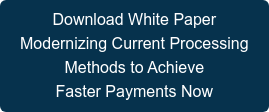
Making it to faster and real-time payments poses real-time challenges for financial institutions as they encounter an exciting new reality. But as the ramp-up continues, there comes the first and most important question: Can our systems handle it?
In search of answers, keep in mind that fast payments shouldn’t mean a rush to judgement. Before racing to replace existing systems, financial institutions should look to modernize them as they implement faster payments step by step. For in truth, the industry’s existing payment systems remain perfectly viable, proven and trusted by customers. Processing methods simply need updates to appear more real-time—even as barriers to customer adoption are removed.
In the second of this two-blog series, we look at the potential of intelligent improvements to make the payments processing methods perform in line with the faster payments era.
What the Industry Needs
For check positive pay, the industry needs a service with end-to-end design that allows financial institutions to retire costly legacy backroom systems and markedly improve operational efficiencies. A SaaS (software-as-a-service) solution designed to perform all of the check positive pay functions currently spread across multiple systems would be ideal. It can ingest check capture and issuance data, identify and alert for exceptions, present exceptions for pay/no-pay decisions, and deliver a disposition file and/or report for return handling. Business clients could provide information about issued checks in any format they chose—seamlessly, through the online portal.
The ACH positive pay experience could improve with technology that triggers an actionable alert whenever an ACH transaction hits a customer’s account. The customer could then prevent unauthorized ACH entries immediately, online or via a mobile device. This real-time ACH approval process would occur before a transaction posts, allowing account holders to easily identify trusted payers. The right ACH positive pay solution would also automate the dispute process, so financial institutions would no longer need to store paper dispute forms in warehouses.
One financial institution found that it could eliminate 10,000 disputes—or an estimated $300,000 in costs—per month by automating ACH positive pay. Financial institutions could even charge customers for the newly automated service; if hundreds of thousands of customers paid two to five dollars a month for the service, that adds up to sizable profits.
For wire transfers, financial institutions need a solution with layered security conveniently intertwined with automated features to combat spam calls, compromised email accounts, and account takeover schemes. The right solution should protect outgoing wire transfers with out-of-band responses through the use of interactive voice response and voice biometric technology. By removing the manual functions behind wire verification, financial institutions can let customers take control of their wires’ security.
With Payment data exchange, financial institutions need a module that enables them to provide clients with Electronic Data Interchange (EDI) information they can export in a variety of formats to automate payments posting. As discussed in our first blog, EDI can be tricky to execute because several standards are in use today, each with different versions. That means businesses in communication must agree on how to connect before data goes back and forth.
The solution would translate the complex EDI 820 and 835 remittance data embedded in ACH transactions and make it usable for businesses of all sizes—whether they use EDI systems or not. Eliminating paper and allowing data to flow seamlessly from one system to another would dramatically improve process efficiencies.
Putting it Together: Repair Rather than Replace
Financial institutions could reap significant value from improving the services they have accepted as “good enough” for years through thoughtful repair. Among the many benefits:
- services become much more marketable to today’s customers, who demand more of their financial institutions than ever;
- check and ACH payments become more useful to clients;
- payment reconciliations improve;
- paper is eliminated; and
- fraud decreases.
At present, legacy systems and processing methods hinder adoption. But if existing processes are improved to make payments faster, adoption should rise considerably. Payments will not only pick up speed, but payment services will also operate with less risk. Indeed, the figurative bottom line becomes the literal bottom line: Profitability rises as the right repairs come on line at the right time.
For more information, download our new white paper, "Modernizing Current Processing Methods to Achieve Faster Payments Now."




